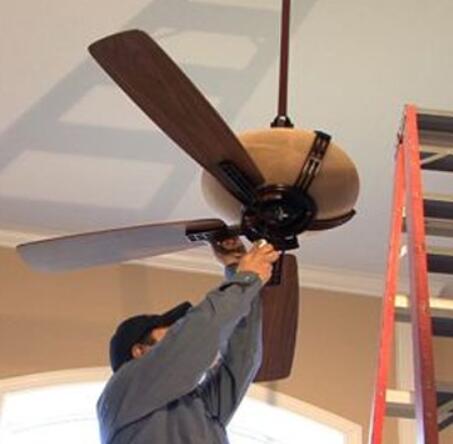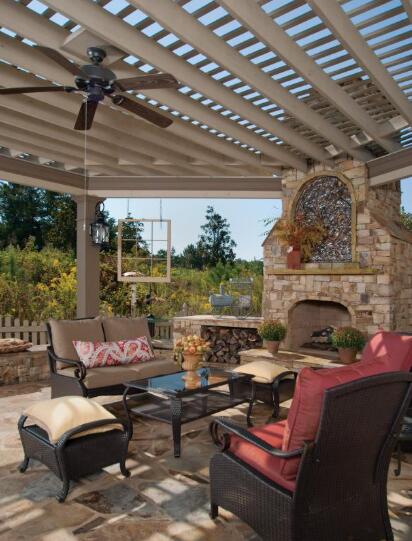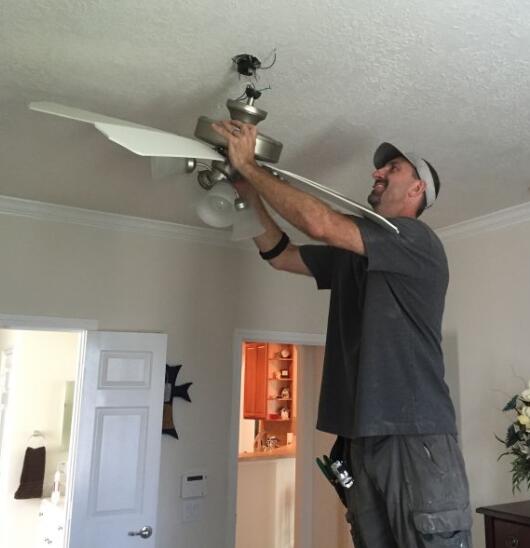A household ceiling fan is essential as it will help to substitute hot, humid air present in the room with fresh, cooler, and drier air allowing additional evaporation and ease in the room you are in. If the interior temperatures are higher than what the bodies need, then the fan mounted on the ceilings tends to drive out heated air efficiently, therefore, cooling of the whole room.
There is nothing good that you can use for cooling down your room, increasing the circulation of fresh air, removing stale small or distributing heat than the use of ceiling fan. Getting new fans or replacing the old ones is fairly simple, and you can get ceiling fans at reasonable prices in the market.
How Much Does Ceiling Fan Installation Cost?

According to the research carried out, it was determined that the cost of installing a ceiling fan ranges from $ 144 to $ 350, with an average cost of $245. This cost is either for an electric or handyman ceiling fan and can as well be determined by the capacity of the placement.
There is a hidden cost that you will incur after installing your ceiling fan, and it is the cost of electricity, as they need almost the same quantity of power energy; therefore, there is a need that your electric circuit is not overloaded. If the electric power from your socket cannot run the fan effectively, then there is a need that you have to source it from the main home panel, and it will require you to incur little cost in installing a new circuit hence increasing the expected electric bills.
Cost To Replace A Ceiling Fan
By room size
There are many designs of ceiling fans from the traditional carved oak to the modern stainless steel that are like the propellers of the airplane. The matching of a given ceiling fan is mostly determined by the size of your room after finding out that a given ceiling fan is suitable in your room the next thing is for you to find out the prominence you want it to have in your room.
If your room is small in size, the use of a large fan will not be appropriate, but if the ceiling high is 16 feet, then the fan will be less noticeable as to match the ceiling fan with the room décor you have to consider a type of color that will complement with it. The size of your room plays a vital role in the type of ceiling fan you need to install.
By fan size
Most ceiling fans are designed in a way that they can distribute the air evenly in a given room; therefore, there are possibilities that your room size can decorate the fan. If you have a very spacious room, then there is a need that you get more than one fan, and the bigger the size of the fan motor will determine its effectiveness and price.
If you consider having one fan to operate your big room, then you have to be considerate of the power that it gives as to meet your needs. You have to weigh the cost with the functionality before making a purchase of a given ceiling fan.
Different Ceiling Fan Installation Cost
Installing Ceiling Fan with a Down Rod

Some of the ceiling fans contain exposed cords that one can plug into the wall socket, but the most preferred type of installation should be the one that the fan is being wired to the ceiling like that of the light fixture. If there had been a fan initially or fixtures for lights, then it is advantageous as it will make installation to be simple as you will be using the existing wires. The first thing that you have to do is turning off your circuit breaker that is supplying current to the ceiling.
Then attach the ceiling plate to the ceiling with the 2 screws that have come along with the ceiling fan to ensure that the screws have not pinched or in contact with the circuit that is between the edge of the ceiling and the plate. Then get the fan motor and attach it to the rook to make sure that the motor’s T slot bracket is over the ceiling projection mounting plate.
Remove the installation circuit wires from the fan pigtail lead and connect the white pigtail lead with the white circuit wire and black with black pigtail lead and secure it with the screws supplied with the fan. Then install the fan paddles and the blades to the motor hub with the screws. Then lastly, you can rotate the blades by using your hand to make sure that there is no rubbing between the fan motor hud and the hugger body, and the rotor cap is as well not rubbing with the body then you can turn the circuit breaker on and test.
Installing an Outdoor Ceiling Fan
For patio and decks that have very solid roofs, an outdoor ceiling fan can be very great and an additional way of keeping fresh air to continue moving things cool. Outdoor fan installation requires only electricity and the feeding wires plus little knowledge of planning and precaution that you can successfully do it by yourself. You have to begin with choosing the type of fan that you want to install outside, and the choice should contain a damp rating, meaning that it is appropriate for outdoor use.

Then take measurements of the central point of your ceiling and mark the location and transfer the taken measurements to the blades of the fan to ensure that it does not come into contact with the lights, beams, or any other obstacle present and should be high enough not endanger anyone’s head. A flip of the circuit breaker then proceeds to drill the ceiling that you are going to place the ceiling fan brace plus the electrical box.
Then install wires from the circuit to the point that the fan will be placed, here you need to pull the wires closer to the wall between the destinations then you can install the electric box now. Stretch it out and mount to the rafters then assemble the fan blades and any other lighting features for the model and make sure that the bolts are tightened when assembling. Then mount the base of the fan to the electric box make sure that the wiring you have done is correct and give a solid connection and secure the fan tightly to the box as it should not be shaking hen it is operating.
Install a Ceiling Fan Where No Fixture Exists

Installing a ceiling fan is not as challenging as you may be thinking of; however, if there are no fixtures in place that you want your new ceiling fan to be, then installing it can be a little bit technical and challenging. First, you need to determine the exact place and point that you want to install your ceiling fan, and generally, it weighs 20 lbs.
Then you have to install it between 2 joints for the case of support. Ensure than the lace you are making holes for installation is between the two joints, and once you get the appropriate location, then you can start with the process of installing the electric fan box.
You have to follow the manufacturer’s instructions and get to address all the possibilities inherent dangers that may arise during the time of installation then begin the procedures similar to the ones described before. The rest of the task requires that you assemble and then hang the fan, but it is important that you have to have a metallic electric box as to support the electric fan, secure well the mounting brackets that are coming with the ceiling fan and test the strong suit of the box by pulling a little bit on it to ensure that it is not moving. And follow the installation information strictly.
Additional Ceiling Fan Features a Cost
Apart from costs that come when installing your ceiling fan, there are other costs that come in the place that is connected to your fan like you can spend little seeking information and research on the best ceiling fan that you prefer having. Ceiling fans can either be designed with light or not, and others come with a remote control device that can cost around $70 to $1100 vary with brands.
It is not necessary to install a new fan due to remote control as the remote control costs about $ 80, and you can get an expert to install it for you as a little cost. Other additional features like the remote application that enable it to work with conjunction with HVAC basing on the temperature inside the room come along with the extra cost.
Buying the Right Ceiling Fan According To Your Room Sizes
There are many leading factors in place that one can consider as guiding before buying a ceiling fan, as it will influence a person to make a choice on which kind is appropriate in his room and size. Definitely, you should take the following aspects into considerations before making a purchase.
The size of the ceiling fan and its blades

Before you making a purchase, ensure that the dimensions of the ceiling fan have been taken into consideration as per the amount of space that it will occupy. This is essential for its installation and operation. The size of the fan should be appropriate according to the room and ceiling space as for you to get the service of the fan where air movement is not blocked by any object near it.
This is very important to avoid risks that might arise after installation, like the fan lying low as a result of it being oversized. Apart from working with the fan, you need to find a safer economical space to store it when not in use.
Cost of the ceiling fan
Different types of fans vary with how much they cost. Ceiling fan machines that record effective performance definitely ought to high prices attached to them. You should always consider buying a good and quality ceiling fan that gives long service and does great and effective work despite its price. High price tag mostly doesn’t guarantee the best quality fans, as prices fluctuate with time brought about by changing levels of demand.
Consider fans that contain good features like; effectiveness, cooling and working tech., size, power consumption, and capacity. The features tend to differ in models and take a step to do research about the products as you make comparisons to find the best in your room.
Quality of ceiling fan
Buy a ceiling fan that is of the best quality as it will not only will it give service in terms of results but also it will be able to serve for years effectively without experiencing any problem, making you get the value of the money you spent on it. The best quality fan gives certainty of service as there are low chances of breaking down or replacing it or some of its parts.
Flexibility and superiority of the fan
When buying a ceiling fan, get to find out its flexibility when you consider changing its location, mounting and installation, its work-rate, suitability, physical make, and effectiveness so as to meet most of the needs that might come up over time. Also consider ceiling fans that can easily be installed, mounted and operated whenever changes arise.
Number of attachments and accessories the ceiling fan has
Consider a fan that comes with many basic attachment features to enable it to be used in different conditions, easy operation, and spaces. It is not adding up for you to consider buying a ceiling fan that will limit its operations by it not being able to support other attachments.
Work output of the ceiling fan
Before picking any fanning equipment, you have to get to know how long it takes to cool a given measure of area or room and the quantity of airflow that can be generated. These factors discussed will enable you to get the most effective and efficient ceiling fan to use in your home and its ability to meet all cooling needs in your room.
Conclusion
The ceiling fan is essential in your home has it has the ability to cool down entire room temperatures by creating wind-like chilling effect inside the room, as the present hot, humid air is being driven out of the room and at the same time is being replaced by fresh, dry and cold air from outside hence providing a cooling effect in the whole room.
By simply blowing air around, the ceiling fan quickens the rate of air to evaporate your sweat and hot, humid air in the room, therefore eliminating heat. The further the rates of evaporation, the cooler will your room temperatures will be. The ceiling cooling fan is very helpful for reducing the high temperature in the room, providing comfortable conditions for you to fit and live in.
